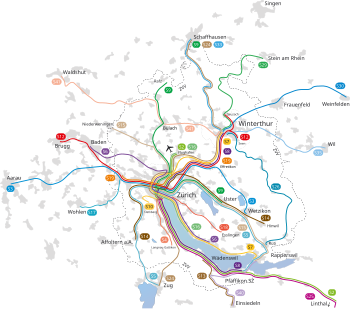Zurich S-Bahn

ZVV logo on the door of
an SBB-CFF-FFS RABe 514. |
|||
| Overview | |||
|---|---|---|---|
| Locale | Zürich, Switzerland | ||
| Transit type | S-Bahn | ||
| Number of lines | 26 | ||
| Number of stations | 171 | ||
| Daily ridership | 409331 (2008) | ||
| Operation | |||
| Began operation | 1990 | ||
| Operator(s) |
Swiss Federal Railways Thurbo SZU SOB FB BDWM |
||
| Technical | |||
| System length | 380 km (240 mi) | ||
| Track gauge | Various | ||
|
|||
The Zürich S-Bahn (German: S-Bahn Zürich) system is a network of rail lines that has been incrementally expanded to cover the ZVV area, which comprises the entire canton of Zürich and portions of neighboring cantons (Aargau, Schaffhausen, Schwyz, Thurgau and St. Gallen), with a few lines extending into Germany. The network is one of many commuter rail operations in German speaking countries to be described as an S-Bahn.
The entire ZVV S-Bahn network went into operation in May 1990, although many of the lines were already in operation.
Unusual among rapid transit services, the Zürich S-Bahn provides first class commuter travel; about one-fourth of seats on each train are first class.
The first step in developing Zürich's rail system which eventually led to the establishment of the S-Bahn was the establishment of the so-called Gold Coast Express (German: Goldküstenexpress) on 26 May 1968 between Zürich Stadelhofen and Rapperswil via Meilen along the wealthy north shore of Lake Zürich, popularly known as the Gold Coast. This development came about because, after World War II, there was a rapid expansion of commuting to Zürich from the former wine-growing villages along the railway line, which originally opened in 1894. As a result, commuters complained that the trains were overcrowded, slow and often delayed.
The canton of Zürich began to develop a project to improve the railway in the 1950s. Because it was not used by either long-distance passenger or freight trains, improvements in local services were possible. Double track sections were built between Kuesnacht and Herrliberg and between Stäfa and Uerikon, along with new stations. The main problem was finance. Development of the line would only serve local interests and would not lead to increased revenue for Swiss Federal Railways (SFR). At the time the canton and cities affected could not fund improvements to an SFR line, so the law was changed to allow local contributions.
...
Wikipedia

